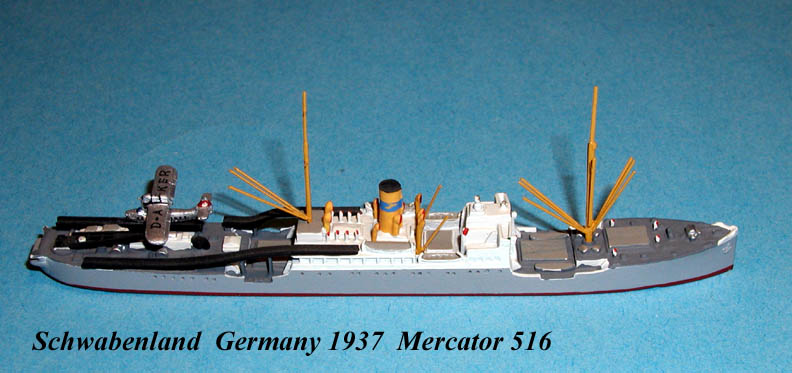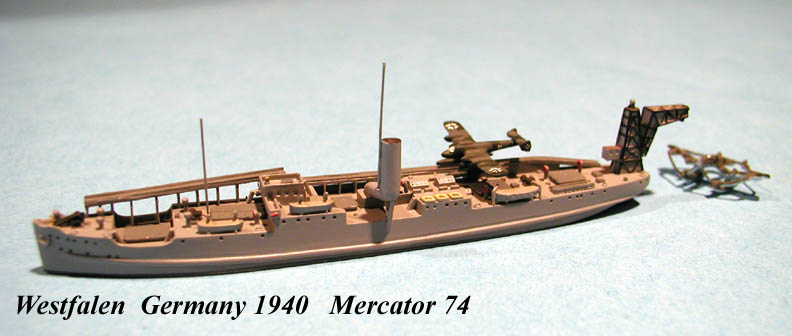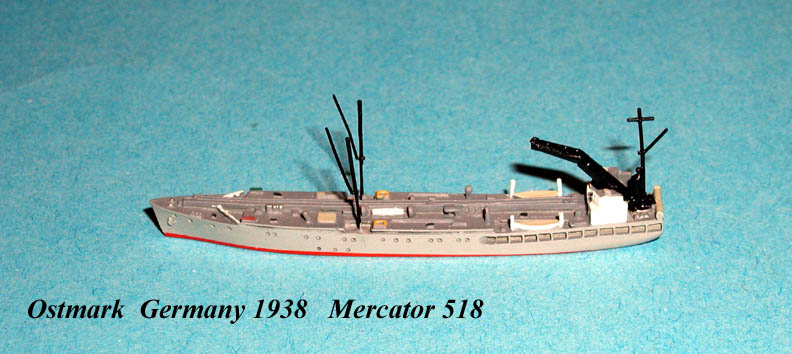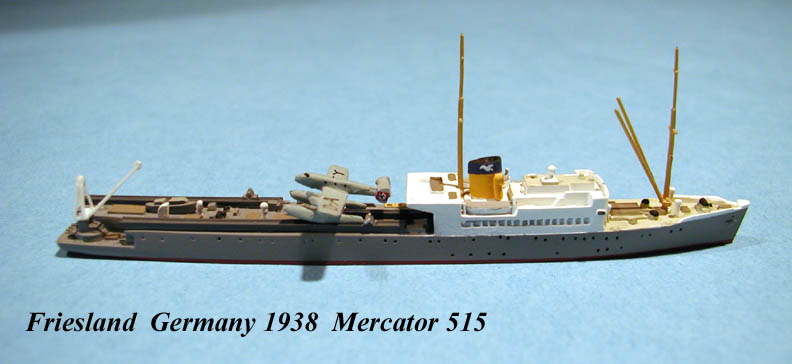| Click to Enlarge |
|
 |
 |
| THE
INTERESTING HISTORY OF THE LUFTHANSA CATAPULT SHIPS By Paul Jacobs |
After the end of the First World War, aviation began to play a role in cargo, mail and passenger traffic. During the 1920's many small aviation companies bid on mail service and in Germany alone, by 1926, some 37 airlines were competing. In 1926 the German government consolidated all airmail service under a single national airline, Deutsche Luft Hansa or DLH, (later Lufthansa). In 1934, in order to compete with the French Aeropostale, DLH started flying mail to South America.
To accomplish this, the mail was flown first to Seville, Las Palmas, or Bathurst (Gambia). It was then transferred to a flying boat. The earliest flights were by Dornier Wals, later Super Wals, and then in 1935, Dornier Do18's. These aircraft lacked sufficient range to cross the Atlantic from Europe nonstop. Instead, the flying boats would land in Tenerife, in the Canary Islands, or Horta in the Azores, for refueling. There they would land and taxi onto a landing mat such as the Hein Mat, and then be lifted aboard ship by crane. Getting and keeping a contract for airmail service depended upon speed of delivery. To assure utmost speed, the mail would be transferred to another plane waiting on board the ship, which would then be catapulted off and on its way.
The catapult ships SCHWABENLAND and WESTFALEN were both created for this purpose. The SCHWABENLAND was the former S.S. SCHWARZENFELD (DDG Hansa, Bremen). Sold to Deutsche Lufthansa AG, she was converted to a catapult ship and entered service in 1934. WESTFALEN was sold to Deutsche Lufthansa AG, and was converted to a catapult ship by Deschimag (AG Weser), being completed in May 1933.
The first regular airmail flight between Germany and Brazil started in February 1934 and was flown from Bathurst by Wal to the WESTFALEN and then on to Natal, Brazil. Flights at first were twice monthly but soon increased to weekly. Mail delivery from Berlin to Natal could be accomplished in four days time.
In September 1934, the larger Super Wal was introduced. This aircraft had the range to fly from Bathurst to Natal, and so the WESTFALEN was repositioned off the coast of Gambia so that it could catapult the ten-ton aircraft for the nonstop flight. For the return flight, the SCHWABENLAND was positioned off Natal, near the island of Fernando de Noronha.
By 1935, mail left Germany every Thursday and arrived in Brazil by Saturday. Mail was also carried by the dirigible GRAF ZEPPELIN, but the seaplane flights were a day faster. However, in November 1935, both catapult ships were withdrawn for repairs and the GRAF temporarily took their place.
In May 1936, the SCHWABENLAND was replaced by the OSTMARK. But the SCHWABENLAND was not withdrawn from service. Both she and another new ship, the FRIESLAND continued in service on other routes. The FRIESLAND was used to launch the newer Blohm und Voss Ha 139 four engine floatplane starting in 1938. By June 1939, these planes had made over 100 Trans-Atlantic flights, 60 of which were across the South Atlantic. An improved version made 26 flights across the North Atlantic. Impressed into Luftwaffe service in 1939, along with their Lufthansa crews they saw limited service because there were only three of them. One was fitted with an unusual magnetic degaussing cable for use in minesweeping, and its first flight in that configuration was made January 19, 1940 in a catapult launch in the Baltic from the FRIESLAND. The last DLH flight to South America was made in August 1939.
In 1938, an unusual event occurred. An expedition to Antarctica was planned for the purpose of exploring the area. In December1938 the SCHWABENLAND with two aircraft left Germany and arrived at its destination in January 1939. The crew and the scientists aboard then proceeded to aerial map and photograph a large portion of Antarctic territory, which was later demarcated as "Neu-Schwabenland". This exploration led to the creation of a number of myths and conspiracy stories which have grown over the years. They include the creation of massive Nazi bases in Antarctica and connections with extraterrestrial spacecraft. According to many of the conspiracy theories, the substantial U.S. Navy involvement in Antarctic exploration in 1946-47, was part of a massive military exercise required to root out the remnants of a vast underground Nazi base established there.
The SCHWABENLAND left Antarctica in February 1939, and arrived back in Germany in mid-April. As a result of this expedition, the ship’s name is still strongly associated with that continent.
In October 1939, SCHWABENLAND was turned over to the Luftwaffe, for service in Luftzeuggruppe See in Kiel. In August 1942 SCHWABENLAND was transferred to Tromso, Norway. On March 24, 1944 she was torpedoed by the British submarine HMS TERRAPIN, near Egersund and was beached. Towed free May/June 1944, she was never fully repaired In February 1945 she became a stores hulk at Oslofjord then in January 1946 an accommodation hulk at Oslo-Sandvika. She was scuttled December 31, 1946 in the Skagerrak with a load of gas munitions.
 |
WESTFALEN was taken over by the Luftwaffe in 1940, and was stationed at Seefliegerhorst Hoornum/Sylt. On May 1, 1941 she went to Trondheim, in 1942 to Altafjord and in 1943 back to Trondheim. On September 7, 1944 she hit a mine in the Skagerrak (near Stora Poolsan), and sank, with the loss of 150 dead.
 |
OSTMARK was taken over by the Luftwaffe September 1, 1940 while in Las Palmas, Spain. She soon sailed for France, but was torpedoed and sunk on September 24, 1940, by the British submarine HMS TUNA southwest of St. Nazaire, on with the loss of only 1 dead.
 |
FRIESLAND was taken over by the Luftwaffe in September 1939. She was stationed as follows: September 5, 1939 at Seefliegerhorst Hoornum/Sylt; April 1940 at Seefliegerhorst Travemunde; September 1940 to Trondheim; October 1940 to Brest and later Bordeaux; September 1941 back to Trondheim; November 1941 to Tromso; February 1943 to Trondheim; July 1943 to Billefjord; torpedoed by Soviet aircraft September19, 1944 in Billefjord, and was beached (2 dead); refloated October 1944 and towed into Bogen Bay, repaired; November 1944 Narvik; March 1945 repair ship in Trondheim; April 1946 to UK; March 1947 to R.A.F.; August 1947 laid-up at Burnt Island; 1949 converted to a refrigerated cargo vessel; March 1950 entered service as Panamanian M/B FAIRSKY; 1952 sold to Italy, M/B CASTEL NEVOSO; 1968 to Panama, M/B ARGENTINA REEFER; June 1969 sold to Shipbreaking Industries Ltd., Faslane, and was scrapped.
 |